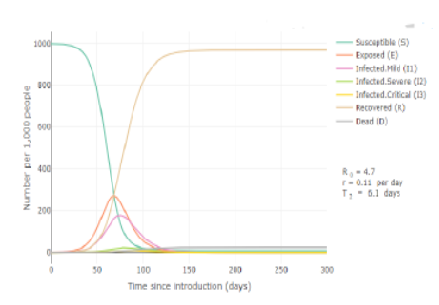


Indian Journal of Science and Technology
Year: 2022, Volume: 15, Issue: 41, Pages: 2162-2170
Original Article
Raghunath Bhadade1, Alwin Anuse2, Rupali Kute1, Mousami Munot3*
1Assistant Professor, School of ECE, Dr. Vishwanath Karad MIT- WPU, Pune, Maharashtra, India
2Associate Professor, School of ECE, Dr. Vishwanath Karad MIT- WPU, Pune, Maharashtra, India
3Associate Professor, Department of E&TC Engg, SCTR’s Pune Institute of Computer Technology, Maharashtra, India
*Corresponding Author
Email: [email protected]
Received Date:21 March 2022, Accepted Date:22 August 2022, Published Date:07 November 2022
Objectives: To develop a reliable mathematical model in order to predict the evolution of various epidemiological factors and parameters for COVID-19 across the globe. Methods: A novel dynamic Susceptible- Exposed-Infected- Recovered-Died (SEIRD) model is proposed in this research. The proposed, two-step approach assumes the infection rate which is dependent on time, to estimate the evolution of various variables of the model. In the first step, parameters like clinical and transmission are estimated, whereas in the second step, simulation of the model is done to predict the outbreak. Findings: Making use of this model, the total number of people who are likely to be afflicted by an infectious disease in a closed population over a period of time can be computed theoretically. Novelty: The proposed model results into low computational complexity since it is deterministic in nature. Secondly, SEIRD model equations are solved in frequency domain that converts the integraldifferential equations into simple algebraic equations. This further reduces the computational burden. Keywords: COVID19; Modelling; SEIRD; Clinical; Transmission; Parameters
© 2022 Bhadade et al. This is an open-access article distributed under the terms of the Creative Commons Attribution License, which permits unrestricted use, distribution, and reproduction in any medium, provided the original author and source are credited. Published By Indian Society for Education and Environment (iSee)
Subscribe now for latest articles and news.